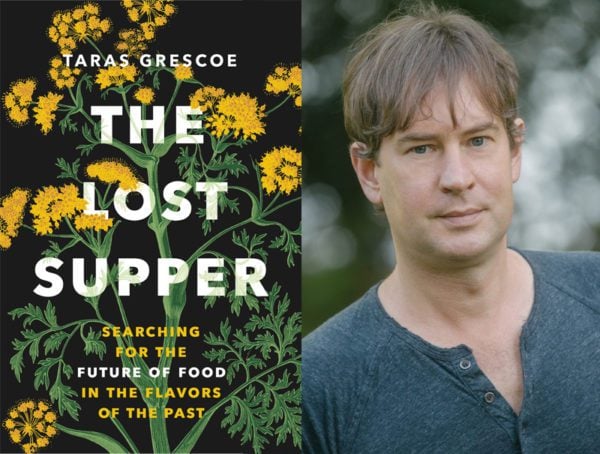
Taras Grescoe (Katia Taylor)
The climate crisis has forced us to re-examine the ways we feed ourselves and to question the best practices for what and how to eat – and especially, why to eat. Author Taras Grescoe (Bottomfeeder, The Devil’s Picnic) travels the world to uncover some traditional and ancient practices that, if widely adopted by Western industrialized nations, could become the future of food and agriculture, and help heal the planet. It is an outstanding and crucial read amid this global emergency.
Grescoe begins his exploration of food sustainability with the practice of eating insects. He travels to Mexico City to trace the consumption of insects back to the earliest known proto-primate, Purgatorius. The author speaks with a paleoanthropologist about these protein-rich nutrient sources and their contribution to the rise of the Aztec empire, positing that “far from being disgusting, [they] are a plausible source of nutrition for the future.”
Next is a trip to Ossabaw, an island off the coast of the U.S. state of Georgia, known for its breed of wild pig, widely considered a delicacy. Grescoe then heads north to St. Helena Island, the heart of the Gullah Geechee Nation, descendants of slaves from western and southwestern Africa, to discuss pigs as a cornerstone of Gullah culture with a local chef. In Charleston, Grescoe discusses the domestication of pigs (the first animal raised for food) and the evolution of their diets with a hog breeder. He declares that “seeking out good meat, from heritage breeds, isn’t a niche pursuit for the privileged few. It’s the decent, healthy, and just thing to do. And because it’s costlier, eating quality pork is something I can’t afford to do often—and eating less meat is certainly better for my well-being, and the planet’s.”
Grescoe extols the virtues of fermentation on a visit to Cadíz in southwestern Spain, where he samples garum, a traditional fermented fish sauce that, not unlike modern fish or soy sauces, provides rich umami flavouring to dishes, and was used in the cuisines of Phoenicia, ancient Greece, Rome, Carthage, and later, Byzantium. He argues for fermentation’s role in the future of food, as it eliminates food waste and is an alternative to the unnatural processing of fresh foods into shelf-stable products.
In the Yorkshire Dales, U.K., he talks cheese and industrial farming, noting, “you should probably be eating more cheese, particularly of the farmhouse variety. Not only is it good for your body, it’s also good for the planet. In fact, seeking out farmhouse cheese—which is simply cheese made on the same farm where the milk is collected—and making it a regular part of your diet is a readily attainable, very concrete step toward healing our broken agricultural systems.” Cheese making is a springboard for a discussion about modern farming: the lack of genetic diversity in cows, the plant diversity that results from sheep grazing the land, and most importantly, the ecological cost of producing meat.
Grescoe then visits Puglia, Italy, to study an alarming disease in the olive trees that propel the region’s economy. The rise of the pathogen Xylella is largely due to the disturbance of the environment – the disappearance of the forests that regulated the ecosystem and slowed the spread of the disease – as well as poor regulations on the importation of plants and fungi. He travels to Cappadocia, in Central Anatolia, Turkey, to explore silphion, an edible plant thought long-extinct due to overconsumption, and Orchis mascula, an orchid used to make salep, a hot beverage famous in the Ottoman Empire that nearly went extinct. These ancient plants facilitate a broader discussion about the overharvesting of herbs and spices to satiate human consumption, as well as the ethics of big corporations controlling trade and contract farming.
Back at his home in Saint-Jean-sur-Richelieu, Quebec, Grescoe reflects on his own eating habits as a result of his journey exploring ancient food. As noted in the introduction, “the first casualty of the agricultural revolution, the story goes, was human well-being.” After farming was widely adopted, humans lived shorter lives; we became prone to disease-carrying pests, and the domestication of animals exposed us to zoonotic diseases. In this chapter, Grescoe focuses on the evolution of bread and the domestication of wheat. Monoculture accelerated the industrialization of agriculture and erased diversity in farming: 95 per cent of the wheat grown for bread is common wheat that was hybridized, either by nature or by design, from emmer and goat grass.
In the final chapter, Grescoe travels to Cowichan Indian Reserve on Vancouver Island, B.C., to discuss Indigenous foodways with Qwustenuxun (Jared Williams), a Coast Salish cook who creates dishes from traditional foods. Grescoe chronicles the ways colonialism changed the land and the foods (such as camas) that fed Indigenous Peoples on the West Coast for generations, and he is hopeful for the reclamation of the land and the food, and, ultimately, the reversal of the poisonous impacts of European diet on Indigenous Peoples. The author contemplates how such traditional knowledge “could benefit all of humanity: a blueprint for food security that [is] based in sustainability rather than extraction, a philosophy deeply rooted in gratitude,” which is something to aspire to for the future of food.
 Contact us via email
Contact us via email

